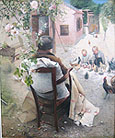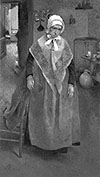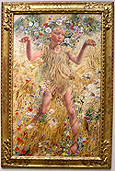The browser will either open the file, download it, or display a dialog.
|
Léon Fréderic's Le Grand-Père (The Grandfather), 1883
|
|||||||
|
This previously unpublished painting (fig. 1) has recently been acquired by an anonymous American collector. Signed and dated 1883 and measuring 111 x 92.5 cm (36.42 x 43.7 in.), it is an important early work by the Belgian painter Léon Fréderic (1856-1940). Formerly in the possession of Georges Hulin de Loo, a noted scholar of early Netherlandish painting, Le Grand-Père, though unpublished, is not undocumented. It is entered in the manuscript inventory of Léon Fréderic's work prepared by the artist's son1 and it is listed in the catalogue of the 32nd Triennial Exhibition held in Ghent in 1883 (XXXIIe Exposition Triennale de Gand, no. 375). | ||||||
| Executed when the artist was in his mid-twenties, Le Grand-Père reaffirms that Fréderic, known today primarily for the symbolist allegories of his mature period (such as the famous triptych, The Golden Age in the Musée d'Orsay in Paris, or the Four Seasons in the Philadelphia Museum of Art), began his career as a naturalist painter. Indeed, after completing his studies at the Brussels Academy, he joined the exhibition society L'Essor, the members of which, mostly former academy students like himself, sought inspiration in real life rather than history or literature. Many of Fréderic's early works show poor people and peasants, especially after 1883, when he moved from Brussels to a small village in the Ardennes region for a stay of several years. | |||||||
|
Perhaps the most striking aspect of Le Grand-Père is that its protagonist, though duly foregrounded, is seen from the back. Seated on a chair and dressed in a heavy coat, a cap on his head and a blanket over his knees, he is turned away from the viewer, who has no more than a glimpse of his cheek. While we cannot see his face, however, we do seem able to look into his mind. Standing behind him, our glance follows his eyes, which appear to rest on two young boys who are feeding a group of chickens. To contemporary viewers, Fréderic's meditation on the cycle of life may appear a little heavy-handed, particularly in such over-determined details as the pink rambler rose that frames the dark figure of the old man. But the painting's message of the consolation that new life brings to old would have found strong resonance in the nineteenth century, when modern scepticism had not yet stolen the cultural scene and when artists and poets did not hesitate to express feelings and emotions in unabashedly sentimental terms. Fréderic's painting may be compared with contemporary literature such as the poem, "The Other" ("L'Autre"), in Victor Hugo's well-known collection How to Be a Grandfather (L'Art d'être grand-père; 1877), which gives expression to very similar sentiments:
It is noteworthy that Hugo wrote these lines when he was a septuagenarian, while Fréderic painted Le Grand-Père in his youth. Indeed, one of the striking aspects of Fréderic's early work is the young artist's focus on old age and death and the related notion of the cycle of life. In 1882, he had painted his first major triptych, The Chalk Sellers (Les Marchands de craie; Brussels, Musée des Beaux-Arts), which was structured in a cyclical manner with its three panels representing "Morning," "Noon," and "Night," respectively. In the "Night" panel, which represents the end of the day and, symbolically, also the end of life, the figures trudging home turn their backs on the viewer just like the old man in Le Grand-Père. |
|||||||
|
While the theme of old age occurs in many of Fréderic's paintings of the early 1880s, the one that seems most closely related to Le Grand-Père is La Vieille servante (The Old Servant) of 1884 in the Musée d'Orsay in Paris (fig. 2). Though larger in size than Le Grand-Père, the two paintings could almost be thought of as pendants both for their similarities and seemingly deliberate dissimilarities. Instead of a seated old man seen from the back, La Vieille servante represents a standing old woman represented frontally, her face with its sad vacant eyes clearly visible. Unlike the old grandfather who is well cared for and, we assume, consoled by the image of his two grandsons, the old servant, no longer able to fulfill her task and presumably childless and poor, is squarely facing Hugo's "half-open tomb and the heavy and cold years." | ||||||
| While the old grandfather is seated in a garden, the servant is standing in an interior space—most likely a kitchen. Yet, though the nature of the two spaces is quite different, their construction is similar as both present a complex arrangement of successive spaces that lend these pictures a convincing sense of depth. It is an arrangement reminiscent of Dutch seventeenth-century painting, particularly of the works of Pieter de Hooch and Jan Vermeer, who favored the use of vistas into other rooms or into the street, both for their perspectival potential and for the possibilities they offered of interesting chiaroscuro effects. | |||||||
|
If is difficult to see the connection between Fréderic's early naturalist works and his later symbolist allegories. How do we reconcile the realism of a painting like Le Grand-Père with the almost surreal qualities of, for example, Summer (L'Eté; fig. 3), one of the four panels of the Four Seasons in the Philadelphia Museum of Art? Its bright, almost psychedelic colors seem far removed from the earthy tones of Fréderic's earlier works; its idealized body different from their realistic figures, and its lack of spatial qualities unlike their pronounced perspective. The radical transformation of Fréderic's style was not an unusual phenomenon, however, among the artists of his generation. Numerous artists born in the 1850s—Pascal Dagnan-Bouveret in France, Jan Toorop in the Netherlands, and Edvard Munch in Scandinavia, to name only a few, went through a similar stylistic change in the late 1880s, as they became increasingly attracted to, and involved with, the Symbolist movement. In Fréderic's case however, it was the form rather than the content of his works that changed. Themes like the cycle of life and its inherent contrasts—youth and old age, life and death—continued to be a major inspiration throughout his career. | ||||||
| Petra ten-Doesschate Chu Seton Hall University |
|||||||
|
1. A copy of this catalogue is in the Musée d'Orsay in Paris. 2. "… Ah! les fils de nos fils nous enchantent,/Ce sont de jeunes voix matinales qui chantent./Ils sont dans nos logis lugubres le retour /Des roses, du printemps, de la vie et du jour!/Leur rire nous attire une larme aux paupières/Et de notre vieux seuil fait tressaillir les pierres;/De la tombe entr'ouverte et des ans lourds et froids/Leur regard radieux dissipe les effrois;… " Author's translation. |
|||||||





